While scrolling on my Instagram feed, I saw a post about a gorgeous planter in my friend’s post. Within minutes, I was asking about the brand and placing my own order.
That’s a classic example of how authentic user-generated content (UGC) works. It’s an organic post about a brand and its products on social media platforms — created by real and relatable customers rather than the brand itself.
In this article, I’ll walk you through everything you need to know about user-generated content — including ways to use it in your social media marketing strategy.
Jump to a section:
What is UGC?
User-generated content is brand-specific content is brand-specific content social media users share on their own accounts. The user content is authentic and untainted by the business’ own input. Brands usually reshare UGC on their own social media channels (with permission!).
For example, at Buffer, we shared this customer review as an Instagram post — it’s the perfect example of user-generated content.
At its core, user-generated content is the digital version of word-of-mouth marketing. However, UGC isn’t as straightforward.
For starters, UGC isn’t as out of your control as word-of-mouth marketing. It’s not reliant on organic content alone to do the work. As a brand, you can integrate UGC into your broader digital marketing strategy to attract new customers.
You can even hire UGC creators to create authentic and relatable content for you when you’re new in business and don’t have many customers or customer feedback. Let’s cover the two types of user-generated content in the next section.
Types of user-generated content
There are two main types of user-generated content: organic and paid.
- Organic user-generated content is consumer-generated content, aka your existing customers create it at no cost. Buyers share social media posts about your brand freely, without asking. This can be photos, reviews, or videos of your customers using your products.
- Paid user-generated content is when you incentivize UGC creators to create content for you with the authenticity of a customer — meaning no false praises or sales pitches. Jenna Libman is a great example of one such creator.
The core difference between organic UGC and paid UGC is the incentive. Organic UGC is unpaid because customers post voluntarily. UGC creators charge for their skills. So, isn’t paid UGC the same as influencer-generated content? Not quite.
- Influencers typically have a larger (and more niche) audience than UGC creators. When you practice influencer marketing, your aim is to reach a new segment of your future audience (the creator’s followers). You pay influencers for their influence — they have developed an online community that trusts them. You seek to borrow that trust by partnering with them.
- UGC creators don’t need to have a large or niche audience. You pay them for their content creation skills. As a brand, you’ll want to post content they create on your own social media accounts.
While these are the two main types of user-generated content, you can also divide UGC based on content type. The brand Lili Origin often uses all these types — I’ll share their examples to help you understand how your company can use various types of valuable user generated content across your marketing channels.
Customer testimonials
Customer testimonials are a powerful form of user-generated content. They aren’t just original, they also signal social proof. You can gather these testimonials from review sites, DMs, email, or any other channel your buyers use to share their feedback.
With explicit permission, you can convert testimonials to visual content by taking a screenshot of online reviews and posting them on social media platforms — like Lili Origin did in their Instagram Stories.
You can also embed these customer feedback snippets across your product pages.
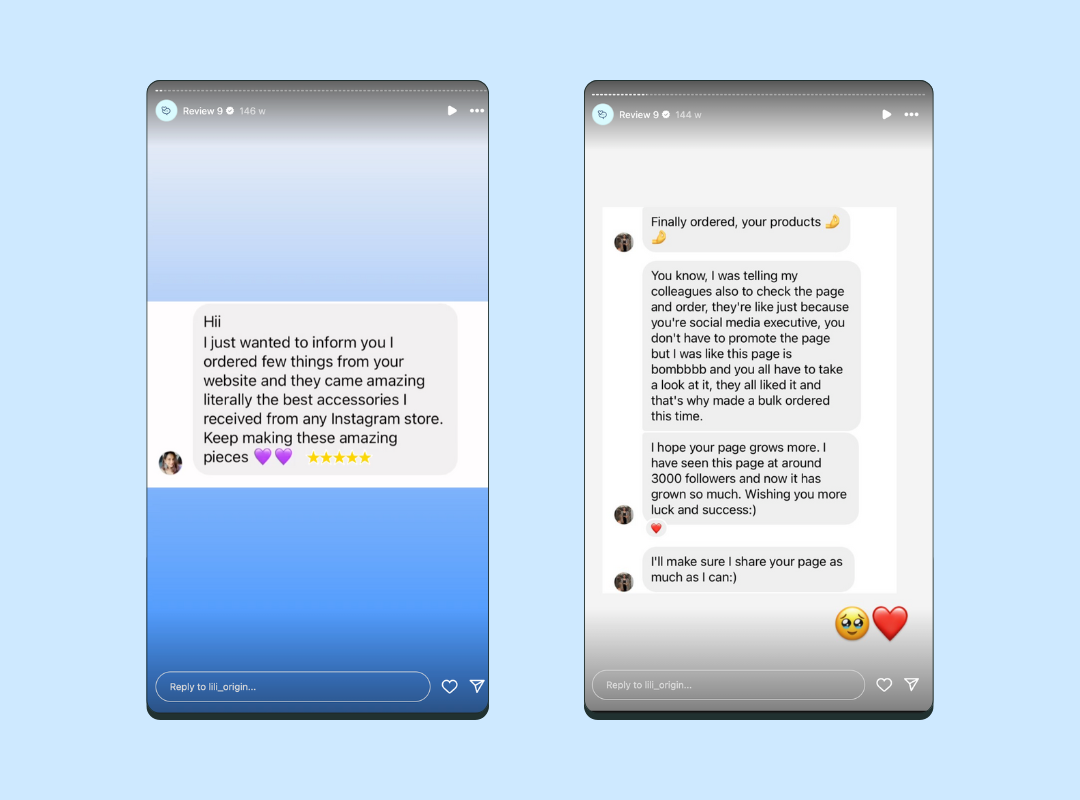
Customer photos
Photos are a type of UGC when a customer uses your product and snaps a picture with it. You can reshare these customer photos as social media posts across multiple platforms and also add them to product pages (so potential customers can see how your product looks on an actual customer).
A pro tip: Add some context to the photo and use the UGC to increase brand awareness.
Lili Origin often reshares its customers’ Instagram Stories, where buyers flaunt the brand’s products. They also add a link to the product in the picture so their followers can find it easily (instead of scouring their website).
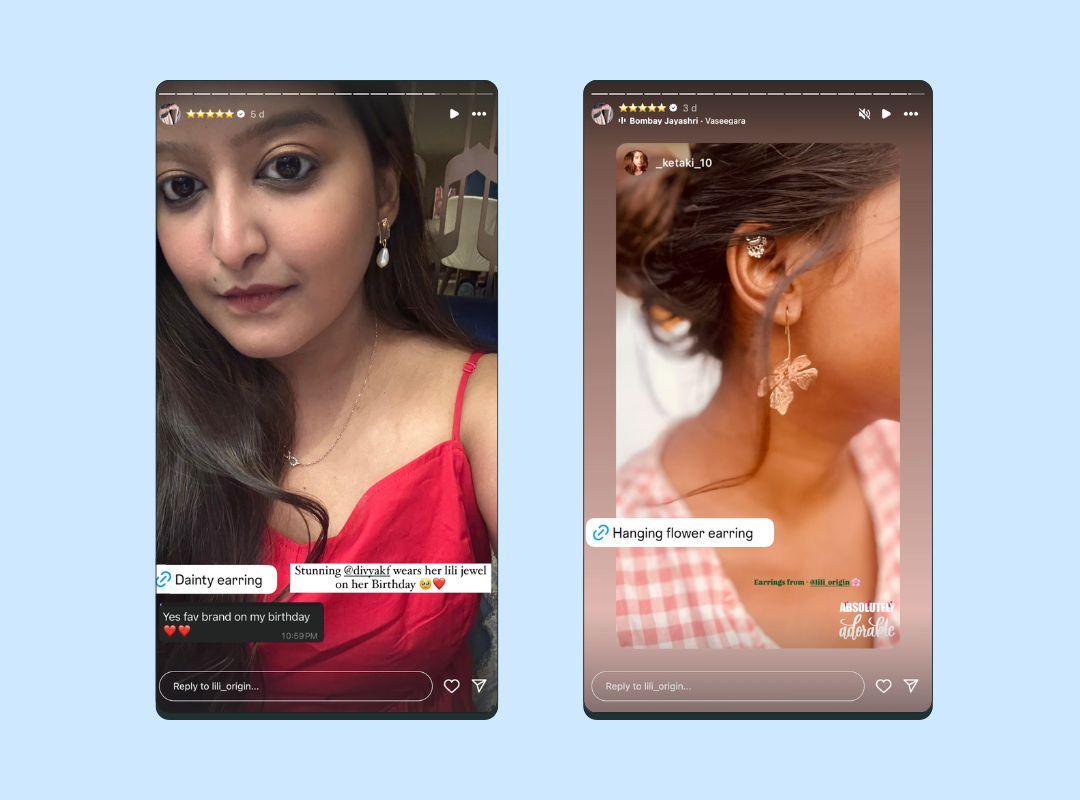
Customer video content
Video UGC is a video related to your product — whether that’s a detailed review, walkthrough, or a haul. Lili Origin shared a creator’s haul of multiple products on their website on their own account.
Blog posts or comments
Blog posts about your product or buyer comments are similar to reviews. You can screenshot mentions across the web (whether that’s in a blog post, Reddit, or in an online community) and share them as UGC content on social media platforms.
Make sure to get permission to reshare reviews, especially when you’re screenshotting content from a private community.
All of the above UGC types can be organic or paid — it depends on how your UGC strategy fits into your overall marketing campaigns.
Before we discuss how you can integrate user-generated content into your brand’s social media strategy, let’s address why UGC content is excellent in the first place.
Why should you use UGC in your social media strategy?
Running UGC campaigns sounds like a lot of effort: tracking all user-generated content, interacting with your audience, resharing it with added context, etc. Why do all that when you can just create branded content or partner with influencers? Here are five reasons that show the value of user-generated content:
1. User-generated content is more authentic
Authenticity has become somewhat of a buzzword online. But the fact is, consumers are more marketing-aware than ever before. They will often tune out of your traditional ads — whether that’s high-resolution branded content or paid partnerships.
In this marketing fog, user-generated posts shine because of their authenticity. They don’t appear salesy. Why else would 85% of consumers say they rely on user-generated content before making a purchase?
2. User-generated content builds your social proof
User-generated content is a trust builder because it comes from your existing customers. It’s powerful when someone buys your product and likes it enough to share it on social media.
It’s not just me who believes it: Massive’s research has found 81% of consumers find user-generated content more trustworthy than professionally created branded content or content from influencers.
When people see someone like them using your products and speaking positively about it — the very core of user-generated content — positive brand sentiment soars.
3. User-generated content boosts brand loyalty
Tint’s latest report found 77% of consumers wish their favorite brands had a community.
And user-generated content is like a mini community-building exercise. It increases customer engagement by providing a space for your buyers to interact and share the content they create.
This further strengthens your connection and lays the foundation of a strong social media community.
When you use user-generated content to deepen relationships and drive community engagement, you also lay the seeds for generating more user-generated content and driving sales.
- 82% of customers are more likely to purchase new products varieties because they engage with it through the brand’s community
- 91% of consumers are more likely to leave a review because they belong to a community
Talk about a win-win.
4. User-generated content can spark content ideas
You can not only share user-generated content to fill your content calendar (with relevant content!) and meet the ideal posts’ frequency across social media channels, but also use the customer content as a treasure trove of ideas and product feedback.
Do buyers often share a use case you don’t speak to in your content marketing efforts? Are reviews frequently highlighting a feature that should be more prominent in your landing page copy? All these are audience insights you can use from an impeccable source: true brand loyalists.
5. User-generated content is cost-effective
If you’re relying on your brand ambassadors or current buyers for creating UGC, you don’t (usually) have to pay them anything to post about your brand.
And even if you have to share some incentives (like an exclusive discount code or a free product), they're a small price compared to traditional advertising costs.
Now that you’re convinced of the value of user-generated content, the next section will help you formulate a strategy to collect, organize, and use it.
How to integrate user-generated content into your marketing strategy
When you’re looking to layer a UGC marketing into your social media strategy, you need systems for three things:
- Encouraging your target audience to share UGC
- Collecting and organizing UGC within your marketing systems
- Using user-generated content created by customers and creators effectively
Let’s cover each one by one.
How to encourage customers to create user-generated content
It'd be so easy if customers automatically shared relevant content about your brand. But that’s not how it works — your target audience needs some encouragement and incentives to create UGC for you. Here are a few ideas:
Guide customers to create user-generated content
Your customers might not think about posting about your brand unless you plant the idea in their heads.
Nudge customers to share how they use your product in your order delivery or marketing emails — be as specific as possible and share exactly what kind of content you expect.
You can also encourage users on social media to create and submit their contributions if they use your product.
The iconic #ShareACoke campaign, for example, asked customers to share their personalized Coca-Cola cans and bottles.
Reward customers for creating user-generated content
Guiding your customers on how to create UGC for your brand is helpful. But giving them a little treat for it is going the extra mile.
Incentivizing customers will not only boost the quantity of user-generated content you receive, but also increase brand loyalty.
You can run giveaways or challenges to encourage customers to participate and share user-generated content on social media.
Domino’s old #PieceofthePieContest is a classic example of how to run challenges to open the floodgates for user-generated content — but you don’t have to offer a $10,000 cash prize.
You can offer exclusive access to new product lines, free merch, discounts, or anything your customers would appreciate.
Encourage team members to create user-generated content
Who knows your product better than the people who helped create it? Ask your team members to post authentic content about your product using their own social channels.
As with your customers, be clear about your expectations and reward teammates for taking the time to create user-generated content.
The best part about team-driven UGC is that your team members are your best brand advocates — they know the ins and outs of your company, what you stand for, and your brand voice.
How to collect and organize user-generated content
It’s easy to keep your UGC library organized when you’re getting only a handful of pieces of content. But what happens when (hopefully!) your UGC library grows — with content from customers, brand ambassadors, teammates, and creators?
The good news: It’s an excellent problem to have. The better news: you can easily solve it by setting up smooth systems to track, organize, and sort user-generated content.
Ask everyone to submit UGC posts using a form
Set up a form to collect user-generated content using tools like Airtable, Notion, or Typeform for your team members, creators, and brand ambassadors.
You can even ask customers to fill out a form if you’re running a contest. This will allow you to collect all user-generated content in one place rather than having it scattered across social channels.
What about customers freely sharing UGC? You don’t want to make them go through the clunky process of filling out a form. Encourage them to use a branded hashtag instead so you can easily collect all user-generated content.
You can take this a step further by using social listening tools to spot content about your brand in the wild.
Set up an integration to store the saved UGC posts in your marketing tools
Integrations can be a lifesaver when it comes to saving time and reducing manual work. If you use Buffer for social media management, you can automatically ensure all the posts submitted via the form appear in your Create space (as post ideas) or drafts.
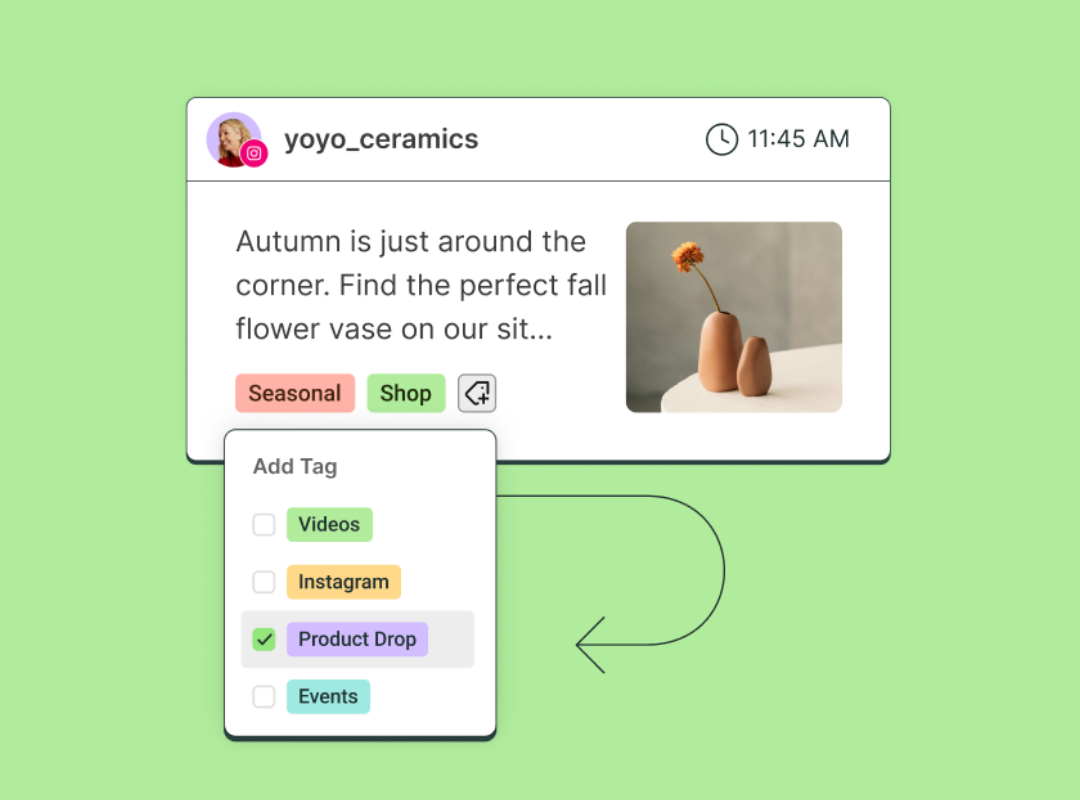
Seek permission as soon as you tag UGC
As soon as you mark a UGC post, send a quick DM, comment, or email to ask the creator if you can reuse their content, and be sure to credit them. Keep the written “yes” on file.
Do you need to ask for permission even for a public post? Yes, every post you see online — public or private — belongs to the original creator. Using someone’s social posts without permission can not only have legal consequences, but also tarnish your brand reputation.
And it isn’t as tedious as it sounds: Using Zapier, you could set up an integration between Buffer, Google Forms (or your form tool of choice), and Gmail (or your preferred email tool).

As soon as you receive a new form response, the integration will automatically create a new idea in your Create space in Buffer.
Here’s how the sequence might look:
- A customer submits a UGC post via a form.
- Their submission is automatically added to your Create space as an idea.
- You tag the idea as "user-generated content."
- A draft is automatically created in Gmail to ask permission to use the UGC post on your own social media accounts.
How to use UGC in your marketing strategy
You’ve encouraged your target audience to share brand-centric content. You’ve even set up the systems to organize it. What next?
Use UGC across different marketing channels
UGC is great for social integration, but it isn’t limited to that.
You can use UGC in multiple places within your marketing strategy — such as product pages, company newsletters, content marketing, and even ads.
Add context to your UGC
Instead of simply resharing UGC, add more context to it for future buyers.
This could mean mentioning the product links your customer is reviewing, or explaining “see how ABC customer uses this product” on your landing pages.
Measure the impact of UGC
If you’re running dedicated user-generated campaigns (like branded hashtags, contests, giveaways), measure their performance over influencer marketing and branded content.
If they get better results (more engagement, higher click-through rates), it’s a positive sign to double down on them. If they’re performing below average, you can dissect why — maybe you’re sharing them at the wrong time or need to add more context.
Now you’ve learned how to create your own UGC strategy. But before you dive into the practical aspect, look at how other brands like yours run user-generated campaigns successfully.
7 great examples of user-generated content
All types of businesses use UGC to generate buzz about their products and create more authentic content. Here are seven of our favorite examples:
1. Alpenglow
This example comes from our own team! Our staff engineer at Buffer, Andy Yates, worked on an app called Alpenglow (among many others).
The app allows users to check sunrise and sunset forecasts for the perfect light quality for shooting photos, and in 2021, it went viral on TikTok thanks to a user’s video showing how the app works.
@bea_carpio_ Espero no ser la unica mega friki de los atardecer así que pls no me ignoreis #sunset #atardecer #españa #spain #lentejas
♬ Into Your Arms (feat. Ava Max) - Witt Lowry
Andy also kindly allowed us to share some statistics on UGC effectiveness through a graph showing significant spikes around the time the user first published the video in July 2021.
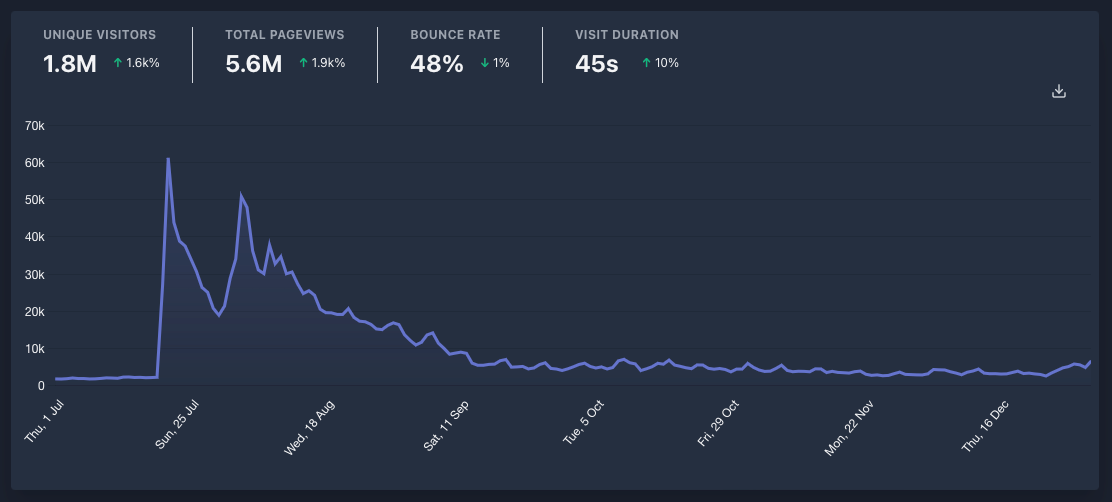
The app also saw an increase in monthly recurring revenue (MRR) when the video went viral in July. The graph below shows that revenue rose sharply to just over $1,200 sometime in that month, up from $200 earlier that year.

Since then, over 2,000 user-created videos have been posted on the Alpenglow TikTok hashtag — pretty incredible reach for organic UGC.
Alpenglow was a side project for Andy, but that one user’s video helped the app grow significantly.
2. Capable Method
Capable Method is an online fitness studio founded by creator Adriana Blanc. On her Instagram account, Blanc often shares client transformations and stories as social proof of how her program improves her customers' health.
This post alone had over 100+ likes (and a lovely comment from the client herself!). Blanc also frequently shares her clients’ messages on her Instagram Stories.
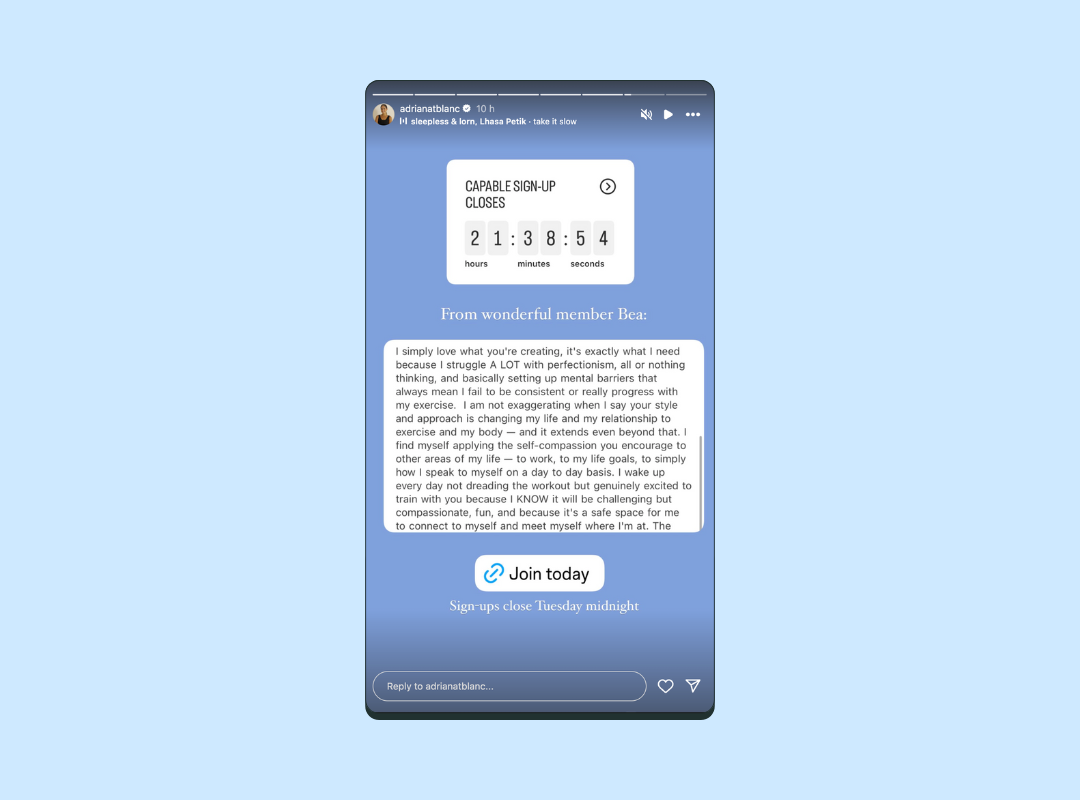
If you’re a founder with a personal brand, share UGC on your own account, too. This will increase their impact and spread the message wider.
3. Casely
Casely is a company that sells phone accessories and covers. They run UGC campaigns that share authentic customer reviews across their YouTube channel.
It’s worth noting that these review series often get more views on their YouTube channel compared to other types of content. Another example of how audience engagement is higher with authentic UGC.
4. GoodRx
GoodRx is a healthcare company that sells medications via its app and website. They asked their customers to share why they love GoodRx and compiled the video to share on their YouTube channel.
This video got over 50,000 views, and the company also remained authentic by disclosing that they compensated the customers for their appearance.
GoodRx has an impeccable UGC strategy where they also create in-depth case studies on specific customers for their marketing content — showing their impact in the best possible way.
5. Dove
Dove has always been big on customer stories — which makes for A+ user-generated content. Take their “Dove hair stories” social media series:
The series not only educates Dove's audience about their product and its benefits, but is also sentimental and relatable to many customers. Each video in this series has at least 10,000 views, with the highest count going over 100,000. 🤯
If your brand is planning a user-generated campaign, take a page from Dove’s book and keep it aligned with your brand identity and values — it’ll make the posts much more you, in the best way possible.
6. Fix My Curls
Fix My Curls is a curly hair care brand selling all kinds of products for people with curly hair. They frequently use their Instagram feed to reshare posts from their customers.
Fix My Curls always adds its own cheeky Instagram caption to the post and credits the original creator/customer. This allows them to add more details about their products without compromising the originality of the UGC.
7. Aavia
Aavia is a period tracker app with a strong Instagram presence. The company regularly shares Instagram carousels from its community of customers who love the app.
Social proof is an integral part of the company’s Instagram strategy — as evidenced by its frequent sharing of customer reviews. I love that they also often resurface these posts by sharing them on their Instagram Stories.
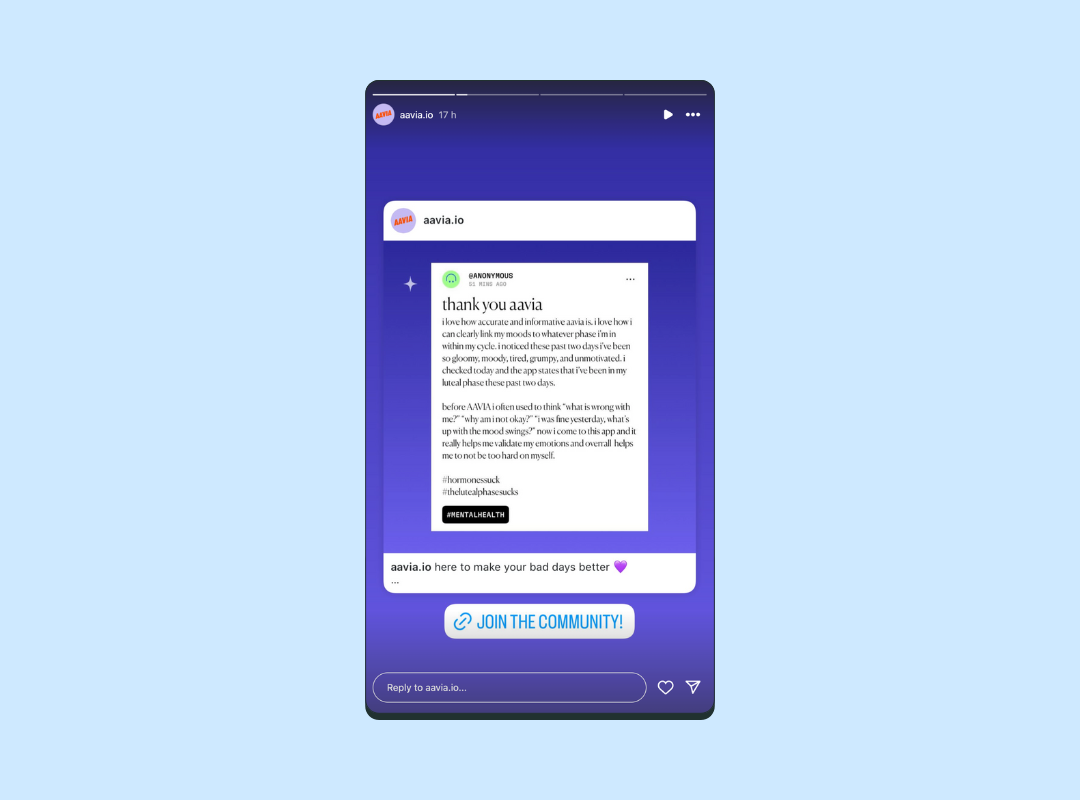
Let your customers do the talking
Once you get the UGC flywheel running, it’s like a shortcut for creating relevant, original content at minimal cost. The important thing is not just having products people would want to rave about, but also offering value to entice your customers to speak up.
And once that happens, you’re all set! Use Buffer to set up not just strong UGC systems, but also a thorough social media management workflow. From scheduling posts, saving UGC, responding to customers, to analyzing posts — we’ve got it all under one roof. Start with a free plan today.
Try Buffer for free
190,000+ creators, small businesses, and marketers use Buffer to grow their audiences every month.




